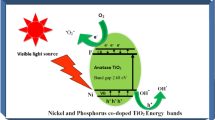Abstract
The synthesis of mesoporous aggregates of titanium oxide nanoparticles (F0) is described using a very cheap and simple synthetic protocol. This consists of the reaction of titanium tetraisopropoxide and a solution of HNO3 in water (pH 2.0) and subsequent filtration. In addition, fluorine-doped titanium oxides (F1, F2, F5 and F10) were synthesized using the same method, adding increasing amounts of NaF to the reaction mixture (avoiding the use of expensive reagents such as NH4F or trifluoroacetic acid). The resulting materials were calcined at different temperatures (500, 600 and 650 °C) giving particles sized between 10 and 20 nm. Furthermore, a hybrid F-doped TiO2 with supported palladium nanoparticles of ca. 20 nm (F5-500-Pd1) was synthesized by grafting an organometallic palladium(II) salt namely [Pd(cod)Cl2] (cod = 1,5-cyclooctadiene). Photocatalytic studies of the degradation of methylene blue (MB) were carried out under UV light using all the synthesized material (non-doped an F-doped TiO2), observing that the increase in the quantity of fluorine has a positive effect on the photocatalytic activity. F5-500 is apparently the material which has the most convenient structural properties (in terms of surface area and anatase/rutile ratio) and thus a higher photocatalytic activity. The hybrid material F-doped TiO2–Pd nanoparticles (F5-500-Pd1) has a lower band gap value than F5-500, and thus photocatalytic degradation of MB under LED visible light was achieved using F5-500-Pd1 as photocatalyst.












Similar content being viewed by others
References
Bayarri B, Gimenez J, Curco D, Esplugas S (2005) Photocatalytic degradation of 2,4-dichlorophenol by TiO2/UV: kinetics, actinometries and models. Catal Today 101:227–236
Chen X, Mao SS (2007) Titanium dioxide nanomaterials: synthesis, properties, modifications, and applications. Chem Rev 107:2891–2959
Cherchi C, Gu AZ (2010) Impact of titanium dioxide nanomaterials on nitrogen fixation rate and intracellular nitrogen storage in Anabaena variabilis. Environ Sci Technol 44(21):8302–8307
Cui Y, Du H, Wen L (2008) Doped TiO2 photocatalysts and synthesis methods to prepare TiO2 films. J Mater Sci Technol 24(5):675–689
Danilchenko SN, Kukharenko OG, Moseke C, Protsenko IY, Sukhodub LF, Sulkio-Cleff B (2002) Determination of the bone mineral crystallite size and lattice strain from diffraction line broadening. Cryst Res Technol 37:1234–1240
Diebold U (2003) The surface science of titanium dioxide. Surf Sci Rep 48:53–229
Dozzi MV, Selli E (2013) Specific facets-dominated anatase TiO2: fluorine-mediated synthesis and photoactivity. Catalysts 3:455–485
Glaze WH, Kang JW, Chapin DH (1987) The chemistry of water treatment processes involving ozone, hydrogen peroxide and ultraviolet radiation. Ozone Sci Eng 9:335–352
Herrmann JM, Duchamp C, Karkmaz M, Hoai BT, Lachheb H, Puzenat E, Guillard C (2007) Environmental green chemistry as defined by photocatalysis. J Haz Mater 146:624–629
Hoffmann MR, Martin ST, Choi W, Bahnemannt D (1995) Environmental applications of semiconductor photocatalysis. Chem Rev 95:69–96
Jin YZ, Zhang YF, Li E (2003) Micro-electrolysis technology for industrial wastewater treatment. J Environ Sci 15:334–338
Kudo A, Miseki Y (2009) Heterogeneous photocatalyst materials for water splitting. Chem Soc Rev 38:253–278
Li D, Haneda H, Labhsetwar NK, Hishita S, Ohashi N (2005) Visible-light-driven photocatalysis on fluorine-doped TiO2 powders by the creation of surface oxygen vacancies. Chem Phys Lett 401:579–584
Luttrell T, Halpegamage S, Tao J, Kramer A, Sutter E, Batzill M (2014) Why is anatase a better photocatalyst than rutile?—model studies on epitaxial TiO2 films. Scientific Rep 4:4043
Mahoney L, Koodaly RT (2014) Versatility of evaporation-induced self-assembly (EISA) method for preparation of mesoporous TiO2 for energy and environmental applications. Materials 7:2697–2746
Mohammed MA, Shitu A, Ibrahim A (2014) Removal of methylene blue using low cost adsorbent: a review. Res J Chem Sci 4:91–102
Sabyrov K, Burrows ND, Penn RL (2013) Size-dependent anatase to rutile phase transformation and particle growth. Chem Mater 25(8):1408–1415
Sami G, Bagani N (2012) Sorption kinetics for dye removal from aqueous solution using natural clay. J Environ Earth Sci 2:30–40
Sánchez-Muñoz S, Pérez-Quintanilla D, Gómez-Ruiz S (2013) Syntesis and photocatalytic applications of nano-sized zinc-doped mesoporous titanium oxide. Mater Res Bull 48:250–255
Sing KSW, Everett DH, Haul RAW, Moscou L, Pierotti RA, Rouquéol J, Siemieniewska T (1985) Reporting physisorption data for gas/solid systems with special reference to the determination of surface area and porosity. Pure Appl Chem 57:603–619
Tan YN, Wong CL, Mohamed AR (2011) An overview on the photocatalytic activity of nano-doped-TiO2 in the degradation of organic pollutants. ISRN Mater Sci 2011:261219
Teichner SJ (2008) The origins of photocatalysis. J Porous Mater 15:311–314
Umadevi M, Parimaladevi R, Sangari M (2014) Synthesis, characterization and photocatalytic activity of fluorine doped TiO2 nanoflakes synthesized using solid state reaction method. Spectrochim Acta A: Mol Biomol Spectro 120:365–369
Vivero-Escoto JL, Chiang YD, Wu KCW, Yamauchi Y (2012) Recent progress in mesoporous titania materials: adjusting morphology for innovative applications. Sci Technol Adv Mater 13:013003
Wang SA (2008) Comparative study of fenton and fenton-like reaction kinetics in decolourisation of wastewater. Dye Pigment 76:714–720
Yang Y, Zhang T, Le L, Ruan X, Fang P, Pan C, Xiong R, Shi J, Wei J (2014) Quick and facile preparation of visible light-driven TiO2 photocatalyst with high absorption and photocatalytic activity. Sci Rep 4:7045
Yu JC, Yu JG, Ho WK, Jiang ZT, Zhang LZ (2002) Effects of F− doping on the photocatalytic activity and microstructures of nanocrystalline TiO2 powders. Chem Mater 14:3808–3816
Yu J, Xiang Q, Ran J, Mann S (2010) One-step hydrothermal fabrication and photocatalytic activity of surface-fluorinated TiO2 hollow microspheres and tabular anatase single micro-crystals with high-energy facets. CrystEngComm 12:872–879
Yue QY, Gao BY, Wang Y, Zhang H, Sun X, Wang SG, Gu RR (2008) Synthesis of polyamine flocculants and their potential use in treating dye wastewater. J Hazard Mater 152:221–227
Zaleska A (2008) Doped TiO2: a review. Recent Pat Eng 2:157–164
Author information
Authors and Affiliations
Corresponding author
Electronic supplementary material
Below is the link to the electronic supplementary material.
Rights and permissions
About this article
Cite this article
Lázaro-Navas, S., Prashar, S., Fajardo, M. et al. Visible light-driven photocatalytic degradation of the organic pollutant methylene blue with hybrid palladium–fluorine-doped titanium oxide nanoparticles. J Nanopart Res 17, 94 (2015). https://doi.org/10.1007/s11051-015-2902-z
Received:
Accepted:
Published:
DOI: https://doi.org/10.1007/s11051-015-2902-z




